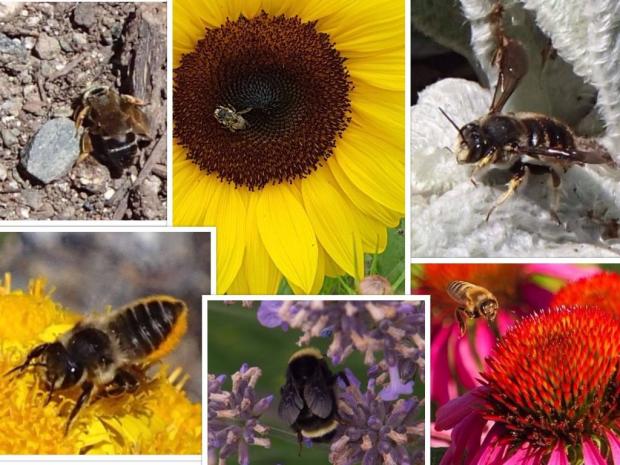Resources
Education

We are facing a 'pollination crisis': bee populations and species are declining as demand for pollination of crops is increasing. Loss of habitat, parasites, pathogens, pesticides, climate change and the movement of bee diseases around the globe all contribute to the decline. Victoria Master Gardeners recently were able to take an advanced training workshop in Creating Pollinator Gardens to help reverse this trend, led by Ted Leischner (planbeenow.ca).
Ted explained that, while most people think of the honey bee as the main pollinator, in south western BC our native bees have been performing much of the pollination heavy lifting for tens of thousands of years. The 200 plus species of native BC bumble bees, mason bees, digger bees, leaf cutter bees and parasitic bees (none of which are hive bees) all need our help. They need adequate nectar and pollen, plus a place to live and reproduce (i.e., habitat).
Home gardeners can make a difference to bees by providing flowers through the seasons and enhancing nesting opportunities. Native flowers are great for our native bees, while many non-native flowers are well known for their nectar and pollen attracting properties (e.g., lavender, heather, clover). There are four different habitats that our native bees need: bare earth for ground nesters (most native bees), wood tunnels (for mason bees), pithy stems (such as raspberry, blackberry etc.) and fist size below ground cavities (for bumble bees).
The bee friendly garden has a number of characteristics:
- Bee friendly gardens are in a sunny and warm site as it leads to high pollen and nectar production. Mediterranean herbs are super bee friendly plants.
- Invasive plants and sod forming turf are not bee friendly but our native bunchgrass is fine as it provides habitat between the bunches.
- Flowering plants in the bee garden are adapted to the features of the site in terms of climate, soil, water availability and drainage. (Right plant right place!)
- Native plants form the backbone of the bee friendly garden. The bee friendly garden is flowerful with both perennial and annual flowers.
- Flowers should be in blocks at least one meter square and should reliably produce high amounts of nectar and pollen. Individual plants don't produce enough nectar to attract the bees. (Another article will cover bee-friendly plants through the seasons.)
- Flowers should provide a variety of shapes and sizes of flowers to accomodate different species. Flowers closest to their wild relatives (e.g. rosa rugosa and simple dahlias) are useful to pollinators, while double or multipetalled flowers, modern roses and overbred flowers are not.
- Pollinator gardens bloom all through the growing season, early spring to late fall.
- Pollinator gardens need routine care - deadheading to produce more flowers and regular (but not excessive) water.
- The garden should provide a variety of nesting sites - small unmulched areas, rotting wood, nest boxes, rough and pithy materials.
- Use mechanical means to deal with pests rather than pesticides - pesticides will kill our bees and other beneficial insects.
- Connect pollinator gardens thoughout and between neighborhoods with pollinator friendly parks, boulevards, hedgerows and vacant lots, as well as wild habitat.
For more information:
- "Attacting Native Pollinators -- Protecting North America's Bees and Butterflies", by the Xerces Society - a good general introduction
- Excellent article regarding the decline of bee populations: "Bee declines driven by combined stress from parasites, pesticides and lack of flowers" by Dave Goulson, Elizabeth Nicholls, Cristina Botias and Ellen Rotherway published in Science May 27, 2015. Vol. 347, Issue 6229.
- "Bee friendly gardens", by Kate Frey & Gretchen LeBuhn, in the GVPL
- "The Garry Oak Gardener's Handbook", by the Garry Oak Ecosystems Recovery Team Society (GOERT, Victoria BC)
- Ted's site: http://www.planbeenow.ca
- UC Berkley bee site: http://www.helpabee.org/seasonal-bee-gardening.html
- RHS (British) bee resource: https://www.rhs.org.uk/science/conservation-biodiversity/wildlife/perfec...
Photo credits: Linda Gilkeson, Nancy Keehr and Kerry Seifried




